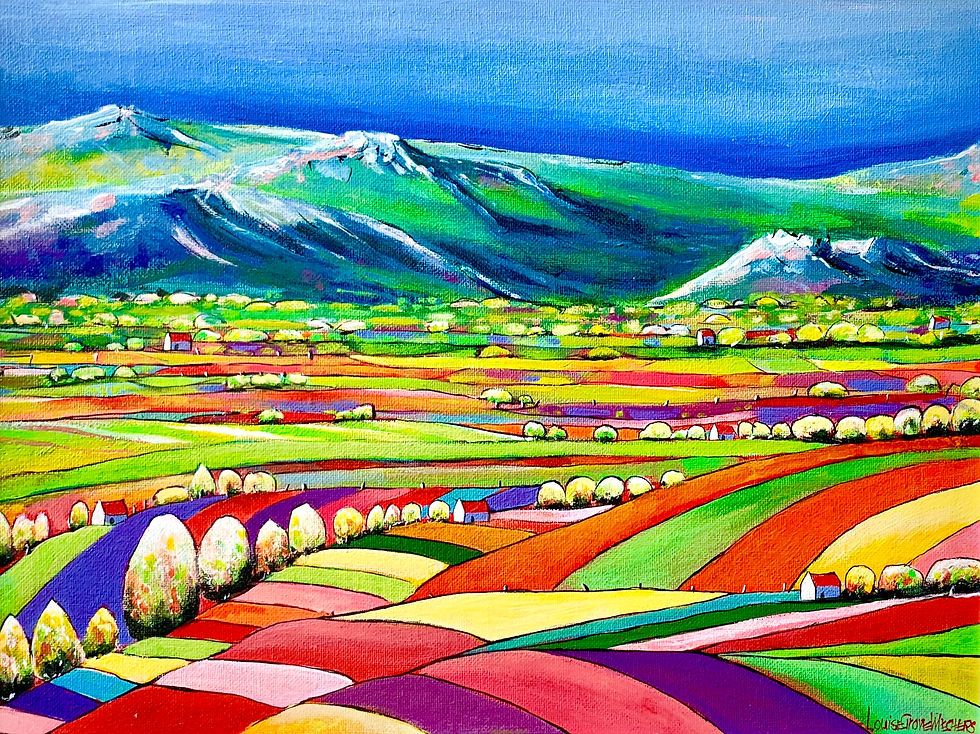An Expression of Rural Living with award-winning artist Louise Grove Wiechers
- At Home With Didiayer

- Nov 21, 2018
- 4 min read
Updated: Jan 1, 2020
Inspired by the natural splendor of Queensland’s scenic rim, Louise Grove Wiecher’s vivid landscapes capture her vision of the ideal rural experience. Often choosing to paint the feeling of a landscape, she concedes to using a great deal of creative license to enhance reality. A native of South Africa with French and Dutch heritage, Mrs. Wiechers, pronounced “vick-ers” has made Australia her home for the past twelve years, a place she has felt a nostalgic connection to due to its similarities to her homeland in both light and topography. Inspired by the vivid colors and textures of the orange groves she once wandered through as a child, she began to express herself though painting. From these humble beginnings, an artist was born, her body of work reflecting the commitment and passion necessary to feed a flourishing career.

“The light, in this part of Queensland is just magnificent, colors become more vibrant . When I paint, I kind of jack up every color, adding a little bit of fluorescence to the paint so that it really pops. I think color is one of my favorite subject matters I use to enhance the landscape.” Louise identifies herself as an expressionist, although she has a vast experience in a variety of mediums. She holds a degree in Fine Arts with a focus in etching and printmaking, but she tends to reserve these forms of expression for her more serious, academic audience. But this prolific painter has also worn the hats of high school art teacher and university lecturer educating students on subjects like interior design while holding public art workshops in the community including the Gold coast and Brisbane. “What I love about Mount Tambourine is that it is a village, but yet it is large enough for a community to exist , with a little bit of anonymity. So you can actually live here, live a quiet life, be part of a community, but you don’t feel as thought the city is creeping up on you. Its ideal for an artist or creative person.”

The Scenic Rim name alone conjures up beautiful images. But it isn’t until you step foot on the mountain that you grasp the full effect it has on the senses, from the sweet scent of jasmine to the competing songs of the Kookaburra, the Cockatoo and the Lorakeet. Louise attributes the wide array of bird life in this area as a major source of inspiration.
“Every morning I wake to the sounds of birds, which is one of the most inspiring things for me,” she admits, toying with the idea of painting birds in the not-too-distant future.
The mountain hosts monthly community artist gatherings where local artists choose new themes for the season, from livestock and local flora, to dilapidated barns and sheds, all of which Louise says keeps her on her toes artistically. “It is quite an inspiration as well as a challenge to rediscover new subject matters.”
With a rare invitation into her Red Barn studio in the heart of the rain forrest, we were lucky enough to sit in as she walked us through her creative process.
“I start with a five or ten minute sketch just to put down the basic design of what I’m planning for the particular painting.”
These “thumbnail drawings” as she describes them, place your subject, in this case a landscape, in a specific space on the canvas which she believes is vital for students to learn composition.
“You can do say, fifteen little thumbnails, then choose the best one (which) becomes the foundation for your painting.”
Louise credits this practice of using different types of atmospheric perspectives to Leonardo DaVinci, whom she studied as a student at university. She reminds us that this technique forces you to think about where your eyes are drawn before adding any paint. At this point she begins the process of meticulously integrating color before applying washes to dissolve the pigments. Today she has specifically chosen to work with acrylics.

“Oils are challenging in the humidity of the rainforest,” she says with a wry smile.
Occasionally Louise will use a combination of mediums. For instance, she may choose to incorporate three-quarters acrylic paint beneath an over lay of oils for clients who insist on an oil painting. These pieces can take anywhere from two to six months to complete due to slow drying times of oil paint, but in the end she wants her clients to be happy and doesn’t seem to mind a little compromise.
“Commercial forms of art are probably some of the most enduring,” she gently reminds us, in regards to discipling herself to stay marketable. “I think if you can produce work that speaks to clients, (but) ones they can buy without having to think about what it is. It requires (an artist) to continuously reinvent themselves, to remain fresh, so that your subject is always new.”
And just when we thought she could not be any more graceful, Louise insists we take the painting as a momento of our time on Tambourine Mountain. We humbly but gratefully acquiesced, but not without her signing it first. As a lefty, Louise has learned to sign her paintings in reverse to prevent the paint from smudging. But is an artists work ever complete?
“When you produce art and then you see your paintings, maybe in a gallery, we are really hard on ourselves. There’s always something you feel you can do better. We are probably our own worst critic.”
More on Louise: https://www.louisegrovewiechers.com/
Written by AHWD contributor Robin Queen



Comments